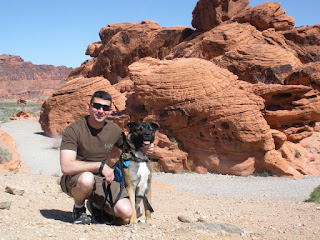
The Valley of Fire derives its name from red sandstone formations, formed from great shifting sand dunes during the age of the dinosaurs. Complex uplifting and faulting of the region, followed by extensive erosion, have created the present landscape. Other important rock formations include limestones, shales, and conglomerates. Prehistoric users of the Valley of Fire included the Basket Maker people and later the Anasazi Pueblo farmers from the nearby fertile Moapa Valley. The span of approximate occupation has been dated from 300 B.C. to 1150 A.D. Their visits probably involved hunting, food gathering, and religious ceremonies, although scarcity of water would have limited the length of their stay.
The Mouses Tank: Named for a renegade who used the area as a hideout in the 1890's. Mouse's Tank is a natural basin in the rock where water collects after rainfalls, sometimes remaining for months. Written on the walls are prehistoric petroglyphs from the people who use to stay in this area.
The Beehives: Unusual sandstone formations weathered by the eroding forces of wind and water.








No comments:
Post a Comment